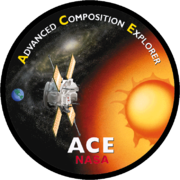Advanced Composition Explorer

An artist's concept of ACE
|
|
| Mission type | Solar research |
|---|---|
| Operator | NASA |
| COSPAR ID | 1997-045A |
| SATCAT no. | 24912 |
| Website | www |
| Mission duration | 5 years planned Elapsed: 19 years, 6 months and 18 days |
| Spacecraft properties | |
| Bus | Custom |
| Manufacturer | Johns Hopkins Applied Physics Laboratory |
| Launch mass | 757 kilograms (1,669 lb) |
| Dry mass | 562 kilograms (1,239 lb) |
| Power | 444 W End-of-Life (5 years) |
| Start of mission | |
| Launch date | August 25, 1997, 14:39:00 UTC |
| Rocket | Delta II 7920-8 |
| Launch site | Cape Canaveral LC-17A |
| Orbital parameters | |
| Reference system | heliocentric |
| Regime | L1 Lissajous |
| Semi-major axis | 148,100,000 kilometers (92,000,000 mi) |
| Eccentricity | ~0.017 |
| Perigee | 145,700,000 kilometres (90,500,000 mi) |
| Apogee | 150,550,000 kilometres (93,550,000 mi) |
| Inclination | ~0° |
| Period | 1 year |
 |
|
Advanced Composition Explorer (ACE) is a NASA Explorers program Solar and space exploration mission to study matter comprising energetic particles from the solar wind, the interplanetary medium, and other sources. Real-time data from ACE is used by the NOAA Space Weather Prediction Center to improve forecasts and warnings of solar storms. The ACE robotic spacecraft was launched August 25, 1997 and entered a Lissajous orbit close to the L1 Lagrangian point (which lies between the Sun and the Earth at a distance of some 1.5 million km from the latter) on December 12, 1997. The spacecraft is currently operating at that orbit. Because ACE is in a non-Keplerian orbit, and has regular station-keeping maneuvers, the orbital parameters in the adjacent information box are only approximate. The spacecraft is still in generally good condition in 2015, and is projected to have enough fuel to maintain its orbit until 2024. NASA Goddard Space Flight Center managed the development and integration of the ACE spacecraft.
ACE observations allow the investigation of a wide range of fundamental problems in the following four major areas:
A major objective is the accurate and comprehensive determination of the elemental and isotopic composition of the various samples of “source material” from which nuclei are accelerated. These observations have been used to:
Isotopic “anomalies” in meteorites indicate that the solar system was not homogeneous when formed. Similarly, the Galaxy is neither uniform in space nor constant in time due to continuous stellar nucleosynthesis. ACE measurements have been used to:
...
Wikipedia
